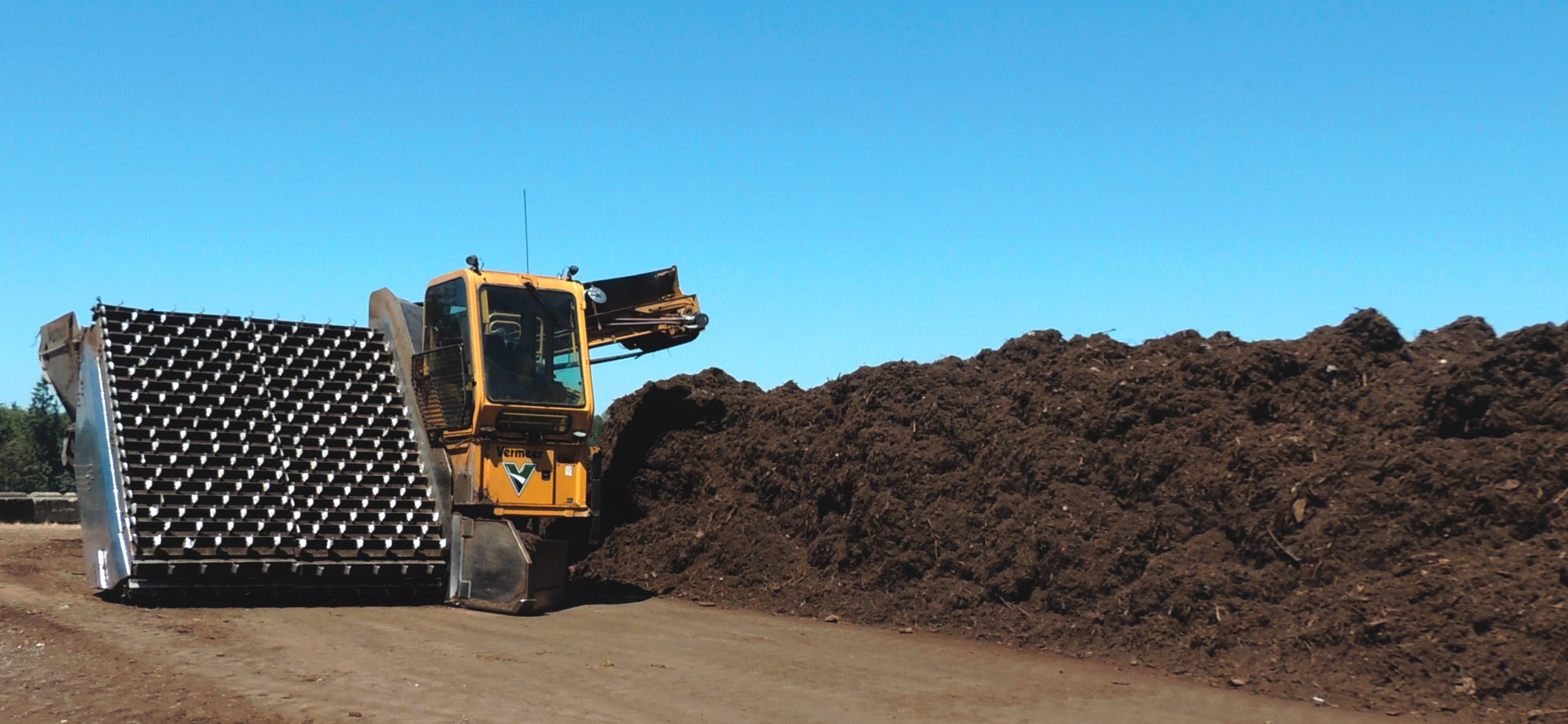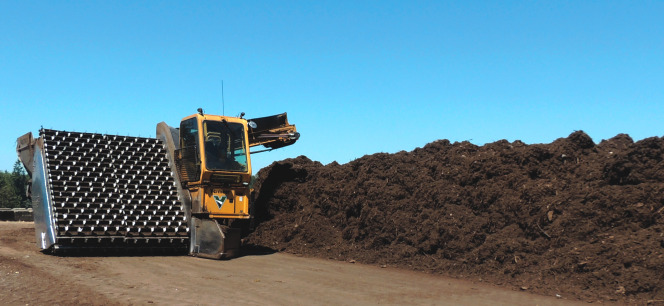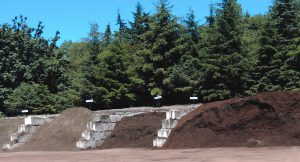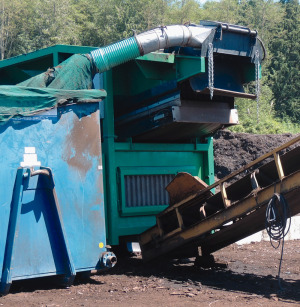Eight months into processing curbside collected source separated organics from the City of Seattle, Lenz Enterprises’ strategy for contaminant removal is effective.
Nora Goldstein
BioCycle December 2014
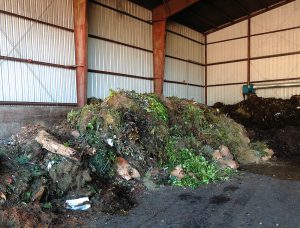
Lenz Enterprises began processing residential source separated organics (SSO) from Seattle in April 2014. Incoming loads are tipped in a 10,000 sq. ft. receiving building.
Lenz Enterprises, in Stanwood, Washington, has gradually expanded into new feedstock streams since it opened a composting facility in 1976. The Lenz family owns a wholesale beef packing company, and began composting as a way to manage manure and paunch from that operation. “We actually had procured this site for our beef packing operations then revamped those plans and decided to develop it into a sand and gravel mining operation,” recalls Jason Lenz, Vice President and General Manager of Lenz Enterprises. “We composted the manure and paunch along with poultry litter from area poultry houses in static piles, then blended one third of that compost with a soil and sand mix. Our site operated under a permit exemption.”
In the mid-2000s, Lenz Enterprises decided it wanted to process other organic waste streams at its facility, including source separated food waste and yard trimmings. It applied for a Solid Waste Permit from the Snohomish County Health District, which would allow the facility to receive food waste. Concurrently, Lenz Enterprises wanted to upgrade its composting system to manage source separated organics (SSO). “We looked at a wide-range of options and selected the aerated static pile (ASP) with a reversing aeration system supplied by Engineered Compost Systems (ECS),” notes Lenz. “It allowed us to achieve regulatory time and temperature requirements and control odors in the first stage of composting. For the second stage of composting and curing, we opted for a mass bed layout with mechanical turning.”
The company received its solid waste permit from Snohomish County in 2008. In 2009, it began accepting seasonal “overflow” loads of yard trimmings and food scraps from other sources in the region.
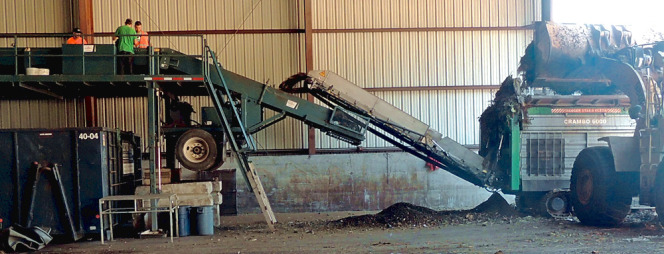
Following processing in a Komptech Crambo slow speed shredder (right), residential SSO is conveyed to a picking line and then passed under a strong magnet. Sorters achieve about 70 to 80 percent contaminant removal.
In 2013, the City of Seattle issued a Request for Proposals for the processing of its residential SOO stream (about 90,000 tons/year). The city awarded the contract to two processors — Lenz Enterprises and PacifiClean, LLC. Lenz was allocated a minimum of 35 percent and a maximum of 45 percent of the Seattle’s organic waste each month, or about 36,000 tons/year. (PacifiClean has been sending its share to Cedar Grove Composting as it has had difficulty with siting its own facility.) The new contracts went into effect on April 1, 2014. The Lenz composting facility is about 50 miles from the transfer station in Seattle. It is receiving about 250 to 300 tons/day of SSO. (Permitted capacity of Lenz Enterprises is 75,000 tons/year.)
Contaminant Removal
To service the Seattle contract, Lenz Enterprises purchased a fleet of trucks and live floor trailers, each with a minimum net capacity of 30 tons/load. The trailers had to be compatible with the city’s waste transfer operations, including the top loading stations and the compactors. “The City of Seattle contracts with CleanScapes (a Recology company) and Waste Management for its municipal collection routes,” explains Hans Van Dusen, Solid Waste Contracts Manager for Seattle Public Utilities (SPU). “Those are mostly residential routes, including apartments, and relatively small commercial accounts. The residential SSO processing contract requires the contractors to receive and process compostable products. These are ‘city-approved compostable bags and food service ware’ that have to meet ASTM standards.”

The first stage
of composting is done in bunkers (left) with ECS
low-friction aeration floors (middle). Once a bunker is filled, the system begins automated operation with reversing aeration mode (positive and negative). Each pile is capped with screened overs that have been run through the site’s Peterson grinder (right). After a pile has met PFRP, it is moved to an adjacent mass bed.
The SPU contract allows the processors to return any contamination sent to them for free disposal at a SPU facility, adds Van Dusen. “Their job is to segregate the contaminants in the loads that the City sends them. We haven’t had any real significant issues with contamination since this contract went into effect in April.”
To comply with Washington State’s revised composting rules that set fairly stringent standards on the quantity of contaminants in finished compost (see sidebar), Lenz Enterprises invested in contaminant removal equipment and trained workers on separation methods. It installed a hand sorting line in its 10,000 sq. ft. receiving building. After unloading, material is put into a Komptech Crambo slow speed shredder. Shredded feedstocks are conveyed to a picking line and then pass under a strong magnet to remove any metal. “The shredded material is pretty bulky,” notes Edward Wheeler, Program Director at Lenz Enterprises. “The sorters pull out plastic bottles, lots of dog toys and golf balls!”
The number of workers on the sort line varies from two to six, depending on the origin of the loads, e.g., multifamily routes versus routes in single-family households. Workers at the picking station achieve about 70 to 80 percent contaminant removal. Additional contaminant removal is performed during screening of the final compost. Lenz Enterprises uses a Komptech star screen equipped with wind sifters to remove film plastic. The patented “pressure-suction” principle of the wind sifter guarantees a high degree of selectivity and is adjustable to specific requirements. As the compost overs come off the outfeed conveyor, they are further cleaned/refined using a Komptech Hurrikan S, utilizing the same patented “pressure-suction” principal of separation. These processes remove the majority of remaining contaminants from the final compost.
Composting Operations
After the sorting line, material is loaded into bunkers separated by concrete walls. One bunker can hold about 780 cubic yards of material. There are a total of eight bunkers. It takes from one to seven days to fill a bunker, depending on the rate of incoming feedstocks. The pile is capped with a 6- to 12-inch layer of screened overs as the bunker is filled. Lenz Enterprises has a Peterson horizontal grinder that it uses primarily to regrind screened compost overs for the pile caps. The unit works really well for that purpose,” says Wheeler.
The system is operated manually in a positive aeration mode until the bunker is full. Running in positive mode during loading and unloading helps prevent the aeration holes from clogging. Once the pile is complete, the system begins automated operation with reversing aeration mode, controlled by ECS’ CompTroller™ aeration control and monitoring system. The temperature probes have two sensors that monitor the top and bottom temperature of the piles. When the system detects a user-specified variance between the two temperature sensors, the aeration mode reverses (switches). “It may be positive, negative or off depending on the needs of the composting process,” explains Wheeler. “This system ensures a homogenous environment throughout the pile and that all parts of the pile reach a minimum temperature of 55°C for at least three days to meet regulatory requirements.”
On average, the piles remain under reversing aeration for 10 to 12 days. Material is then moved to the mass bed, where it remains for 45 to 120 days, depending on how quickly the compost meets regulatory requirements and demand for the product. The bed is turned a minimum of every seven days with a Vermeer elevating face compost turner. Material is monitored daily for moisture, temperature and oxygen. Water is added as needed to keep material within best management practices for moisture content.
Some of the compostable products break down immediately in the primary composting reversing aeration phase; the majority disintegrates by the end of the secondary mass bed phase. “I have never seen a BioBag at the end of our process,” notes Wheeler.
Condensate/leachate is collected by the ECS low-friction aeration floor in the bunkers during primary composting and directed to a sump, then pumped to a modified sequencing batch reactor (SBR) for treatment. Biological oxygen demand is reduced significantly during the treatment process. The facility has a lined lagoon to capture storm water and preprocessed condensate/leachate from the SBR. A wedge wire screen removes about 80 percent of the solids from the SBR, which are then composted. All water that is captured and treated is used in the composting process to maintain adequate moisture. The Lenz composting system is a zero-discharge facility.
Process air from the bunkers — during negative aeration — is treated with ECS-designed biofilters made from ground stump wood. There are about a dozen neighbors within a one-mile radius of the composting site. “Because the Lenz composting facility is located in a convergence zone, air mixing and dispersion is enhanced,” adds Lenz. The facility has an on-site weather station to monitor wind direction, and operators use this information to make important decisions that might have an impact on local air quality.
In addition to a solid waste permit from the Snohomish County Health Department, Lenz Enterprises also has an Order of Approval from the Puget Sound Clean Air Agency. This approval required temporary installation of an odor monitoring system that measures and reports results in odor units (OU)/cubic meter for two operational areas — the aerated static pile bunkers and the mass bed processing area. To comply, the company installed an Odotech monitoring system, which has electronic noses (e-noses) positioned near the odor sources — one located on the back wall of the ASP zones and the other on the northwest corner of the organics receiving building. Sensor data is automatically logged by the Odotech system and Lenz uses this information to develop reports for the agency.
Lenz Enterprises’ compost product line is called GreenBlenz, which is for sale in the company’s own retail yard. It also sells compost, mulch and various soil blends in bulk to other distributors. No bagged product is available. Lenz also makes a Certified Organic GreenBlenz from yard trimmings and ground wood.


